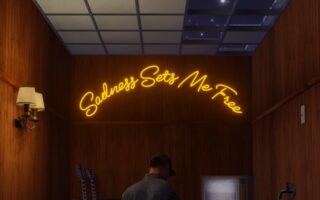
Nowadays it seems there are more scenes to belong to than there are people, whereas in Britain 30 years ago there were only four – or at least it felt like it.
Number one was the casual; typically mulleted, emotionally repressed and happy to educate you with his sovereign rings or reinforced moccasins.
The second group were Goths who, perhaps sensing the widespread public skepticism of their wardrobes and penchant for snake bite, kept themselves to their nocturnal selves.
The third were heavy metal fans; christened ‘Smellies’ by one and all and of no relevance to this story. The final tribe were the awkward, socially challenged group of proto-hipsters who shuffled nervously under the tag of ‘Alternative’. With their paisley shirts, turn ups and suede shoes, when they looked in the mirror they saw a scion of old Jimmy Dean himself, when the rest of the world just clocked a spotty geek pretending to read Voltaire on the night bus.
Being in either designation 2 or 4 could result in at best unprovoked scorn from Johnny Casual, the physical danger posed by nonconformity in Thatcher’s culturally retarded decade being a constant one. In Thatch we had a pantomime villain, in the NME we had a manifesto, and from the middle of the decade we had our own music, a sound with its traits pinched wholesale from 60’s pop, Lenny Kaye‘s Nuggets, post punk and the Velvet Underground.
Not in reality one scene, but a group of them, propagated by tape sharing networks and fanzines united only by their appalling spelling. Some of that which could be classed as ‘Alternative’ was collected together in 1986 on a tape compiled by the NME, craftily entitled ‘C-86‘ and boasting 22 tracks of what was unconsciously to shape huge swathes of British non-chart music for the next 30 years.
At the time its critics were almost hilariously pissed off about the creative limitations of the selected talent pool, and those accusations were in some cases patently true. The absence of acts from labels like 4AD equally, though, helped to distance the exercise from any accusations of pretentiousness, which another similarly big group of outraged critics were poised ready to wade in with.
With expectations low, the first listen was very close to getting a tape from someone in your network (normally from somewhere as exotic and far away as Devizes). There were the ones you loved the moment you heard them; Primal Scream‘s gorgeous ‘Velocity Girl‘, the adrenaline of The Bodines‘ ‘Therese‘ and the scouring, broken neck pace of The Wedding Present‘s ‘This Boy Can Wait‘. Then there were the tunes which grew on you, self confident delights such as The Close Lobsters, Fuzzbox, The Servants and McCarthy.
Finally there was the stuff that didn’t really seem to fit, songs that seemed like appendages sewn onto Frankenstein’s torso. Into this category fell the gloriously daft Stump (‘Buffalo‘s first line: ‘Big Bottom/Swing Big Bottom’), the acquired taste that was Half Man Half Biscuit and The Shrubs‘ ‘Bullfighters Bones‘, a desiccated funk odyssey which seemed to regard time signatures as another band’s problem.
To the extent that most of the artists failed to make it out of the decade intact, let alone bother the charts, the album’s impact could be argued as minimal. A handful of them managed to escape the blight of being included to reinvent themselves (Bobby Gillespie being the most unlikely survivor), but going into 1987 and beyond, the word ‘legacy’ when talking about ‘C-86’ was still infrequently used.
A peculiar alignment of circumstances made sure it did though. As the phrase indie transitioned from being your record’s distribution deal to merely how it sounded, a stagnant pop market, a new generation of hungry label bosses and a public whose curiosity had been piqued by The Smiths co-opted the industry at large. This fertile chutzpah has enjoyed several different guises since, but it’s been used by everyone from Britpoppers to the Arctic Monkeys to grease the pole. In hindsight, almost by osmosis ‘C-86’s cache has hugely surpassed its event horizon.
That’s sort of the context behind the decision to give it a deluxe re-release, expanding its original track numbers to over seventy and jumping formats from tape to CD in the process. Why such an eighties period piece should be given a contemporary makeover is a dubious thought, but it certainly can’t be argued that the much broader scene is in doing so catalogued in a much more comprehensive way. Filling out the package there are also semi-encyclopedic liner notes from NME protagonist of the time Nail Taylor and, as the press release says, some pretty pictures, mostly you assume of some less than pretty bands.
The sheer volume of new songs defies the capacity of this review to touch on more than a handful of them, but broadly they sound like most of the rest of the stuff on the original edition and in that you probably have the answer as to why so many of them are, its claimed, previously unreleased or wilfully obscure (14 Iced Bears anyone?).
Being churlish is of course an ugly, archaic British trait, so to retort its equally brilliant to hear the brutal simplicity of Jesus & Mary Chain‘s ‘Inside Me‘ again, or BMX Bandit‘s ramshackle slacker anthem ‘E-102‘. Some scene doyens get the obligatory but deserved nod too (The Membranes, The Band of Holy Joy, Biff Bang Pow!) although the inclusion of the Happy Mondays‘ ‘Freaky Dancin‘ is welcome but slightly baffling, given that the Madchester movement they co-fathered with The Stone Roses effectively did for this strain of polytechnic rock.
For all its faults – one this re-issue does little to address, probably consciously – ‘C-86’ remains an artifact that directly continues to prompt the fringes of modern music (the new Parquet Courts album being a virulent example). Naively perhaps it’s also possible to believe that it came from a time when music mattered more, where every Wednesday its soul was dissected in the pages of specialist broadsheets like the NME.
That there was even a debate about its motives simply doesn’t translate to now, with print journalism in irrevocable decline and the art form having all but disappeared from terrestrial television. Do these rose tinted memories mean that it’s out of time then? Certainly. Is this edition over specified ? Probably.
Does it remain essential listening though, at least once? Most definitely.
(Andy Peterson)




